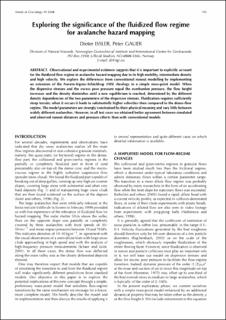| dc.contributor.author | Issler, Dieter | |
| dc.contributor.author | Gauer, Peter | |
| dc.date.accessioned | 2023-09-19T17:41:44Z | |
| dc.date.available | 2023-09-19T17:41:44Z | |
| dc.date.issued | 2008 | |
| dc.identifier.issn | 1727-5644 | |
| dc.identifier.uri | https://hdl.handle.net/11250/3090617 | |
| dc.description.abstract | Observational and experimental evidence suggests that it is important to explicitly account for the fluidized flow regime in avalanche hazard mapping due to its high mobility, intermediate density and high velocity. We explore the differences from conventional runout modelling by implementing an extension of the Norem–Irgens–Schieldrop (NIS) rheology in a simple mass-point model. When the dispersive stresses and the excess pore pressure equal the overburden pressure, the flow height increases and the density diminishes until a new equilibrium is reached, determined by the different density dependencies of the two parameters of the dispersive stresses. Fluidization requires sufficiently steep terrain; when it occurs it leads to substantially higher velocities than compared to the dense-flow regime. The model parameters are strongly constrained by their physical meaning and vary little between widely different avalanches. However, in all test cases we obtained better agreement between simulated and observed runout distances and pressure effects than with conventional models. | en_US |
| dc.language.iso | eng | en_US |
| dc.publisher | Cambridge University Press | en_US |
| dc.subject | Avalanche-RnD | en_US |
| dc.subject | Snøskred-FoU | en_US |
| dc.title | Exploring the significance of the fluidized flow regime for avalanche hazard mapping. | en_US |
| dc.type | Journal article | en_US |
| dc.rights.holder | International Glaciological Society | en_US |
| dc.source.pagenumber | 193-198 | en_US |
| dc.source.volume | 49 | en_US |
| dc.source.journal | Annals of Glaciology | en_US |
| dc.identifier.doi | 10.3189/172756408787814997 | |
